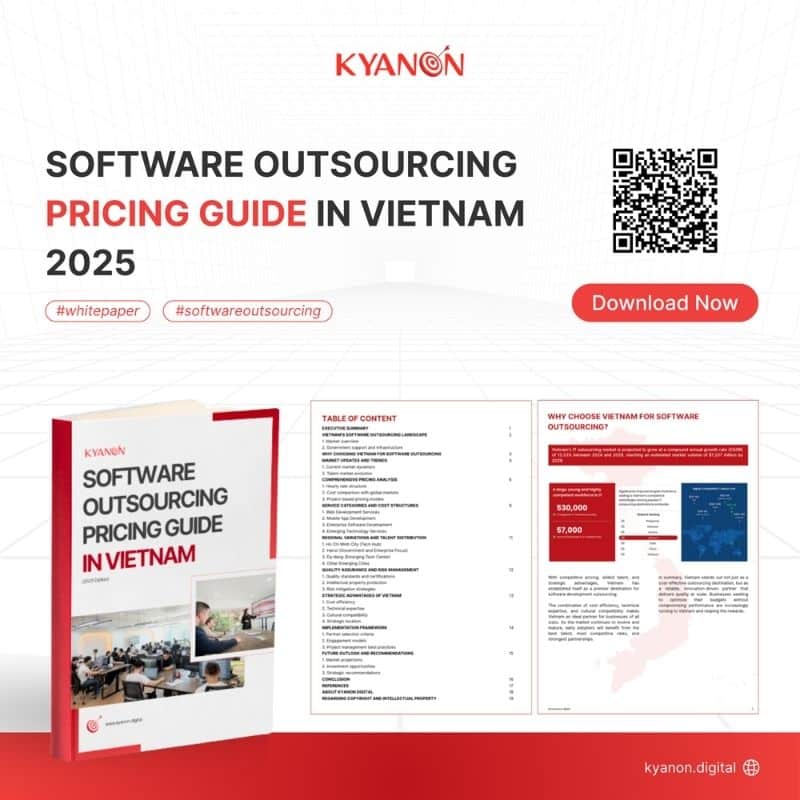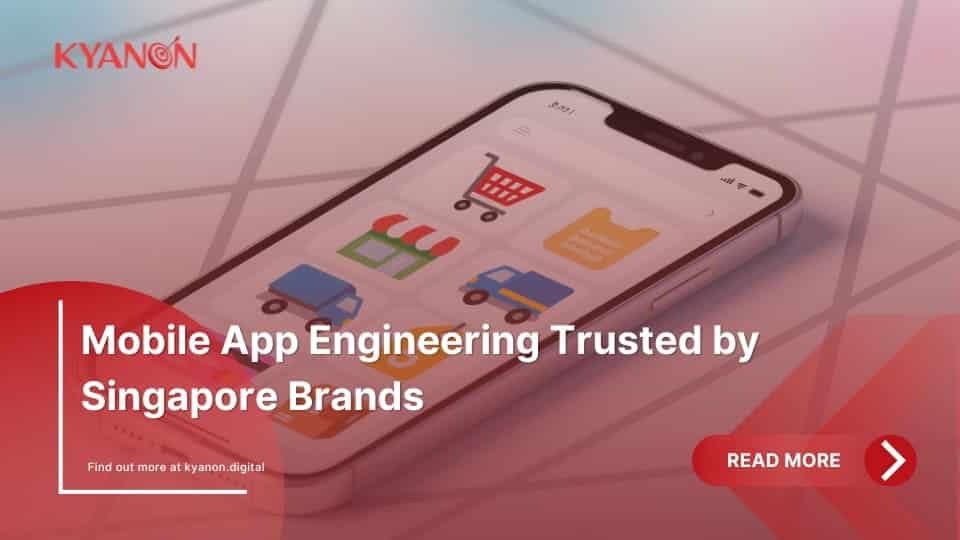In today’s era of constant digital disruption, technology alone isn’t enough – businesses need strategic alignment between IT and business to unlock real value. A strong IT business partnership transforms IT from a support function into a driver of growth, agility, and innovation. Yet, many organizations are far from realizing this potential.
In this blog, you’ll explore what a true IT business partnership looks like, the core principles behind it, how to structure the relationship for success, and why Kyanon Digital is your trusted ally in this journey. Keep reading to discover how to transform IT from a cost center into a competitive advantage.
TL;DR
- Problem: Many organizations struggle with misalignment between their IT strategy and overall business goals. This gap often results in inefficiencies, slow decision-making, and technology investments that fail to deliver real value. Without a clear connection between IT initiatives and business priorities, teams work in silos, and opportunities for innovation are missed.
- Solution: The way forward is to establish a strategic IT business partnership, one that goes beyond technical support and becomes a driver of business outcomes. This kind of partnership is built on shared goals, mutual accountability, and ongoing collaboration between IT and business stakeholders. When both sides are aligned, IT becomes a proactive contributor to business success.
- Step: To make this partnership effective, start by identifying high-impact areas where IT can deliver measurable value. Clearly define the roles and responsibilities of IT business partners to ensure accountability and transparency. Finally, embed a structured engagement model that facilitates regular communication, joint planning, and continuous alignment across functions.
- Result: With a well-established IT-business partnership, companies can respond more quickly to change, drive innovation where it matters most, and maximize the return on their technology investments. The outcome is not just improved efficiency, but real, measurable business impact driven by smarter use of IT resources.
What is an IT business partnership?

A strategic IT business partnership is a collaborative relationship where IT and business teams jointly define goals, co-own initiatives, and measure success through business outcomes, not just technical delivery.
According to Gartner, CIOs who proactively partner with business leaders and align IT initiatives with strategic goals are significantly more likely to drive measurable business outcomes. In fact, Gartner research highlights that organizations with high-performing CIOs often attribute their success to the CIO’s role as a business strategist, not just a technology leader.
At Kyanon Digital, we help companies move from isolated IT projects to integrated digital strategies by embedding our experts alongside your business teams.
Transform your ideas into reality with our services. Get started today!
Our team will contact you within 24 hours.
Why IT should be a strategic business partner?
Many enterprises still treat IT as a cost center, but forward-thinking companies see IT as a value generator. When IT is engaged early in decision-making:
- Digital products reach the market faster
- Technology roadmaps align with business objectives
- Risks like shadow IT and integration gaps are minimized
Case in point: Spotify’s tech and product teams work hand-in-hand, enabling rapid experimentation and continuous delivery, a key reason behind their market agility. (LinkedIn)
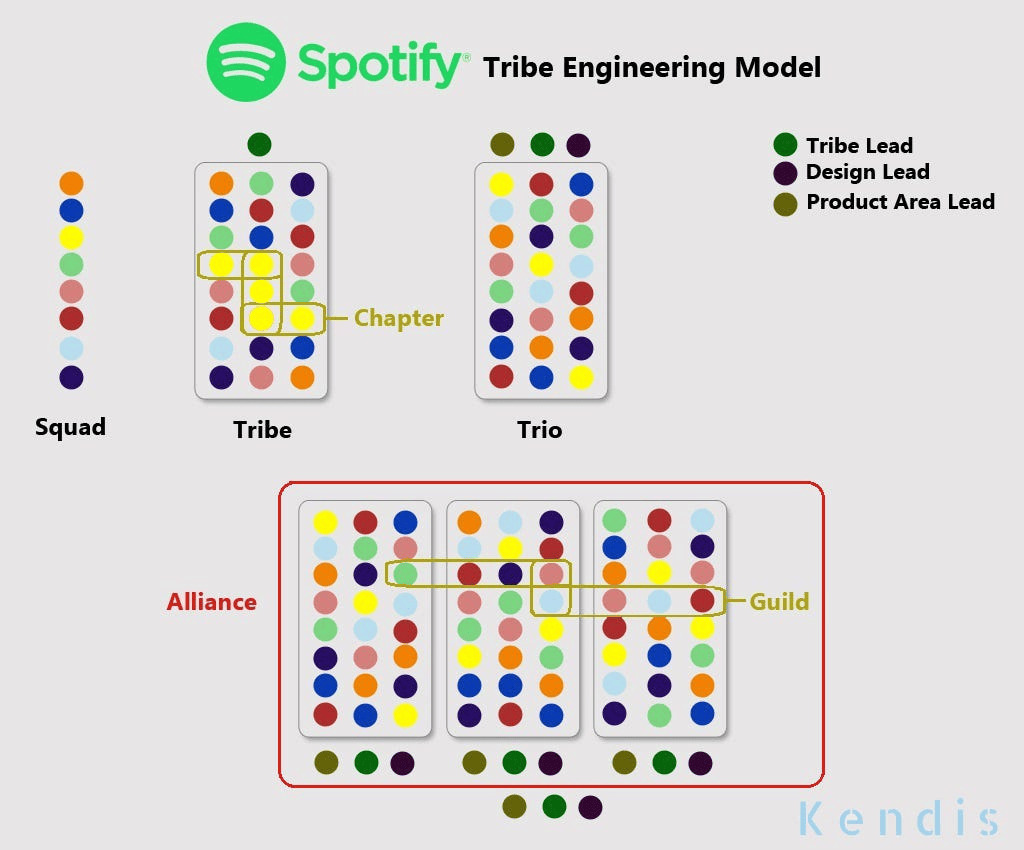
Business outcomes from Spotify’s Agile adoption:
- Release Cycle: Reduced from several months to two weeks, achieving a 40% increase in delivery speed.
- User Satisfaction: Improved from 72% to 85% in recent surveys.
- Employee Engagement: Increased by 25%, reflecting higher motivation and job satisfaction.
- New Features Launched: Over 50 new features introduced in 2023, showcasing a commitment to continuous improvement.
IT is no longer just about keeping systems running. It’s about enabling innovation, data-driven decisions, and customer-centric design.
Core principles of a successful IT-Business partnership
To truly maximize business value, organizations must shift from viewing IT as a service provider to embracing it as a strategic enabler. A high-performing IT business partnership is grounded in a shared purpose, co-ownership of outcomes, and proactive collaboration. These 5 guiding principles define the foundation of such a partnership.
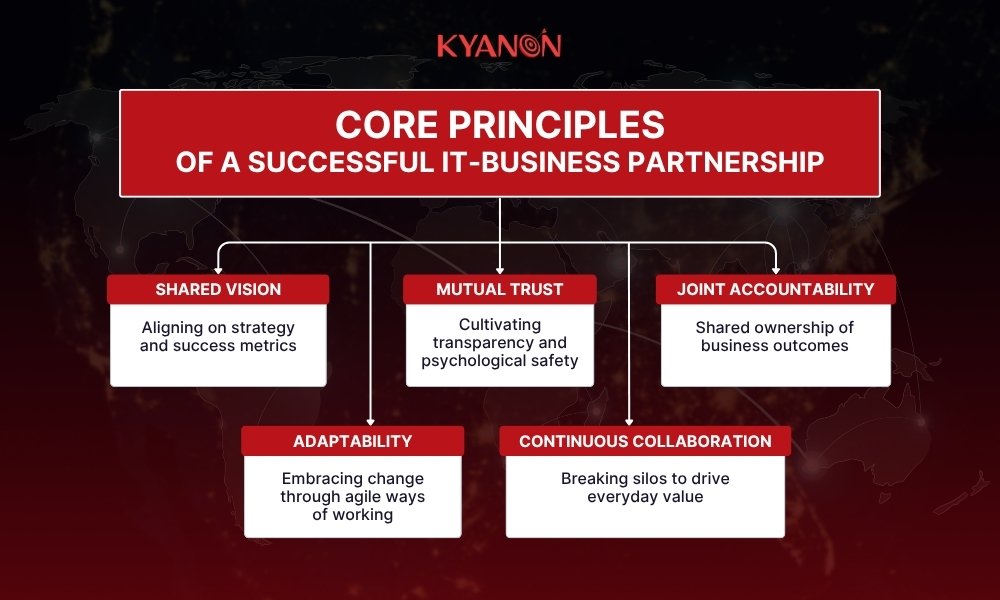
1. Shared vision
- Align early on business strategy and success metrics.
- Go beyond technical outcomes – focus on customer satisfaction, revenue growth, or operational efficiency.
- A shared vision ensures IT initiatives directly support business transformation.
2. Mutual trust
- Build transparency through open, two-way communication.
- Create psychological safety where both sides can surface risks and challenges early.
- Trust empowers teams to take smart risks and innovate confidently.
3. Joint accountability
- Measure IT and business teams by the same KPIs – like time-to-market or cost efficiency.
- Avoid siloed goals; use shared dashboards and clear governance to track progress.
- Co-owning outcomes strengthens alignment and commitment.
4. Adaptability
- Embrace agile ways of working.
- Cross-functional teams should test, learn, and adapt in real time.
- Flexibility allows IT to stay in sync with fast-changing business needs.
5. Continuous collaboration
- Integrate IT into daily business operations, not just planning sessions.
- Early involvement enables proactive problem-solving.
- This approach transforms IT from a reactive support role into a co-creator of business value.
Understanding IT business partner roles and responsibilities
Clearly defining IT business partner roles and responsibilities is essential to avoid misalignment, duplicated efforts, and delivery bottlenecks. Rather than focusing solely on infrastructure or support, the modern IT business partner operates at the intersection of business strategy and technology enablement.
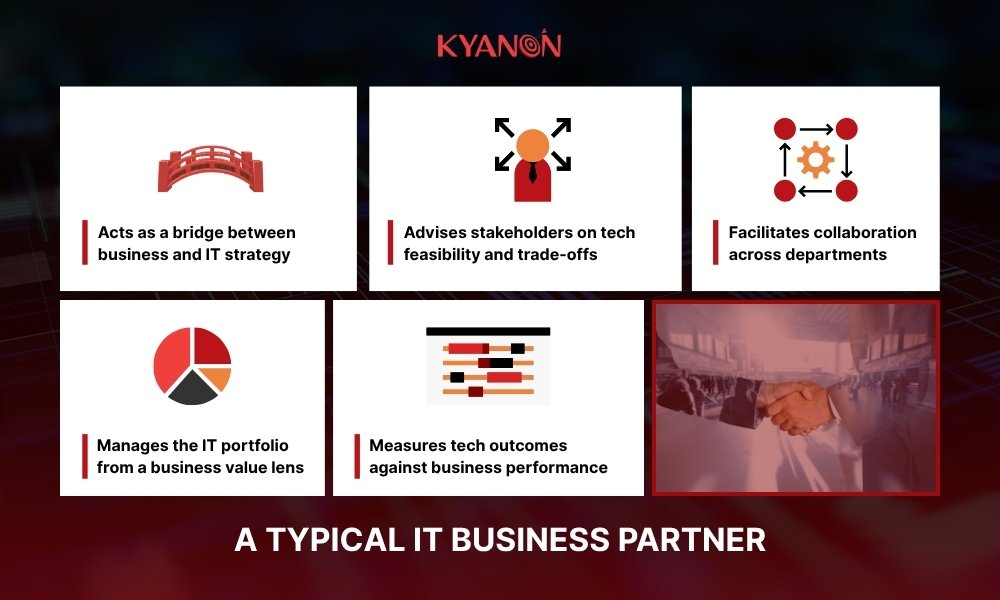
Below are five core responsibilities of a modern IT business partner:
Strategic bridge between business and IT
- Acts as a translator of business strategy into IT initiatives.
- Aligns tech priorities with the company’s roadmap.
- Ensures digital solutions are both practical and aligned with long-term goals.
Technology advisor and consultant
- Provides guidance on tech feasibility, costs, and business impact.
- Supports non-technical leaders in making informed, data-driven decisions.
- Often leads the evaluation of new tools and platforms.
Portfolio manager with a business lens
- Oversees IT initiatives with a focus on ROI and business value.
- Reallocates resources based on performance or strategic shifts.
- Continuously assesses the impact of tech investments.
Cross-departmental collaboration facilitator
- Connects IT with departments like marketing, product, and operations.
- Aligns expectations between technical and non-technical teams.
- Builds consensus to ensure smooth implementation of tech solutions.
Outcome-driven performance tracker
- Tracks success based on business KPIs – not just technical ones.
- For example, deploying an AI system that reduced inventory overstock by 18% (Aglowid IT Solutions).
- Defines and monitors measurable business outcomes from IT efforts.
How IT accelerates business value
A recent study by West Monroe shows that digitally mature organizations consistently outperform their peers when it comes to both revenue growth and profitability. Such performance often stems from a well-structured IT business partnership – where IT is embedded as a strategic enabler rather than a back-office function.
Here’s how IT, when embedded as a strategic partner, contributes to tangible business value:
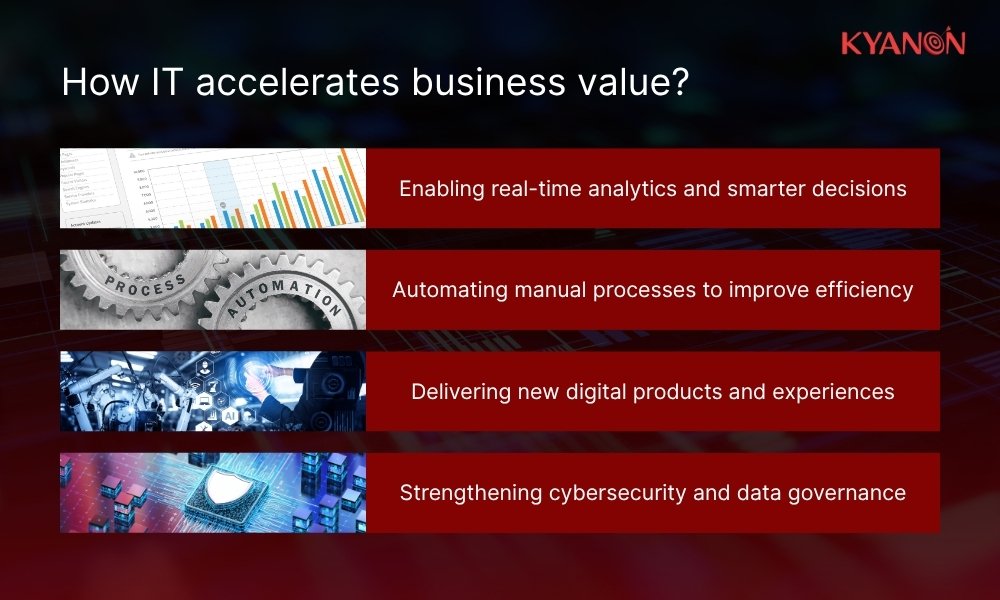
Real-time data and smarter decisions
- Integrated systems and AI tools provide instant, accurate insights.
- Leaders can react quickly to market shifts with predictive models and dashboards.
- Data-driven decisions lead to faster, more confident actions.
Increased operational efficiency through automation
- IT partners implement tools like RPA and workflow automation.
- These solutions speed up processes, reduce human error, and cut costs.
- Automation also frees up teams to focus on higher-value work.
Accelerated product innovation and market delivery
- Agile and DevOps practices shorten development cycles.
- Cross-functional teams boost speed and quality.
- 89% of executives (IBM, 2025) believe AI will drive innovation – highlighting IT’s evolving role in co-creating products, not just supporting them.
Enhanced cybersecurity and governance
- Security is built in from the beginning – not added later.
- IT ensures systems are compliant, resilient, and trusted.
- As Deloitte predicts, cybersecurity spending is rising – proof that governance is now a key value enabler, not just a defensive measure.
Case study: ING’s agile IT-business partnership
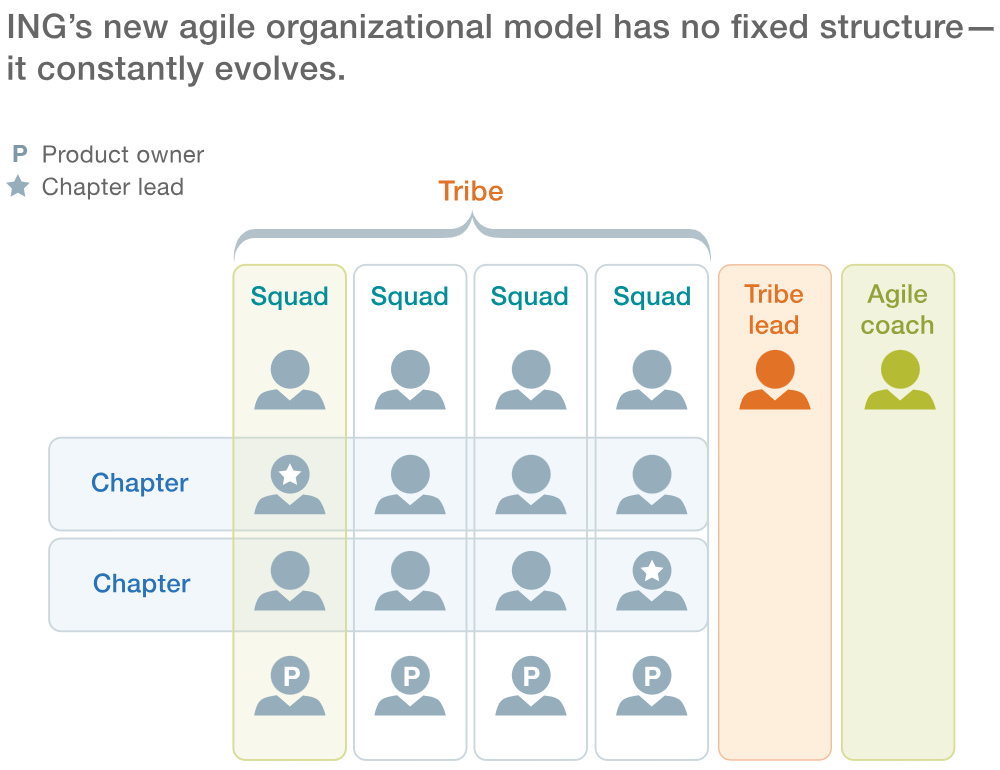
ING, a global bank based in the Netherlands, exemplifies how a strategic IT business partnership can unlock real business value. By adopting an agile operating model and embedding IT professionals directly into cross-functional business squads, ING reduced time-to-market for digital services by 50%.
This deep integration allowed the bank to deliver mobile banking innovations more rapidly and enhance customer experience significantly. The result was not just faster delivery, but also stronger alignment between technology and customer-centric business goals.
Embracing an effective IT business partner engagement model
A well-structured IT business partner engagement model ensures collaboration is not left to chance. It creates intentional, repeatable, and scalable processes that embed IT into the business rhythm – driving both delivery consistency and innovation.
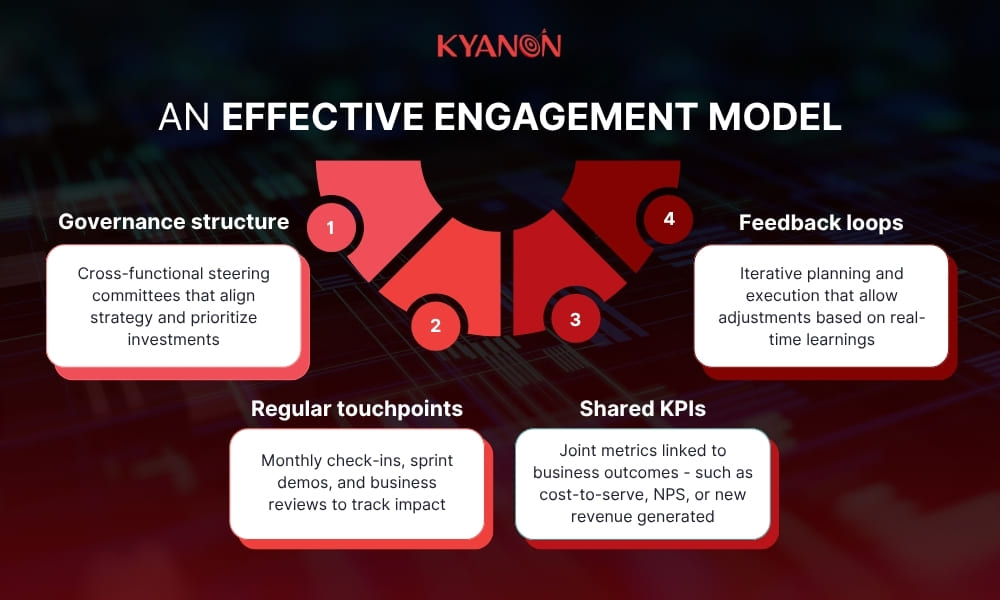
Governance structure: Strategic alignment from the top
- A strong governance framework anchors the partnership.
- Cross-functional steering committees – made up of senior IT and business leaders – align priorities, approve key investments, and guide long-term planning.
- This ensures IT is involved in strategy, not just reacting to it.
Regular touchpoints: Sustaining momentum and visibility
- Ongoing communication keeps IT in sync with shifting business needs.
- Monthly reviews, sprint demos, and planning sessions help surface issues early and drive fast decisions.
- These checkpoints build transparency and shared momentum.
Shared KPIs: Measuring what matters most
- Both sides should be measured by common goals.
- Go beyond technical metrics and focus on business outcomes like: Customer NPS, Cost-to-serve, Digital revenue growth.
- This reinforces joint ownership and results-focused execution.
Feedback loops: Enabling iterative improvement
- Real-time feedback helps teams stay responsive.
- Agile ceremonies – such as retrospectives and backlog reviews – enable continuous refinement.
- This iterative model helps the organization adapt and evolve quickly.
Organizations that adopt such structured engagement models reduce friction, accelerate time-to-value, and enhance their ability to scale digital initiatives sustainably.
Building a collaborative culture between IT & business
Creating a collaborative culture between IT and business requires more than organizational structure, it relies on the right mindset, mutual respect, and consistent interaction. IT is often seen as a service provider rather than a strategic partner. To shift this perception, leaders should focus on:
- Promoting shared goals and a common language
- Encouraging joint planning and open communication
An effective IT business partner engagement model supports this cultural change. Activities that help include:
- Joint workshops
- Job-shadowing
- Cross-training programs
These practices build empathy, break down silos, and improve collaboration. Over time, this leads to a culture where IT and business work as true partners, sharing both responsibilities and outcomes.
Case study: Scaling Accenture’s Digital Capabilities with Kyanon Digital’s Dedicated Software Engineers
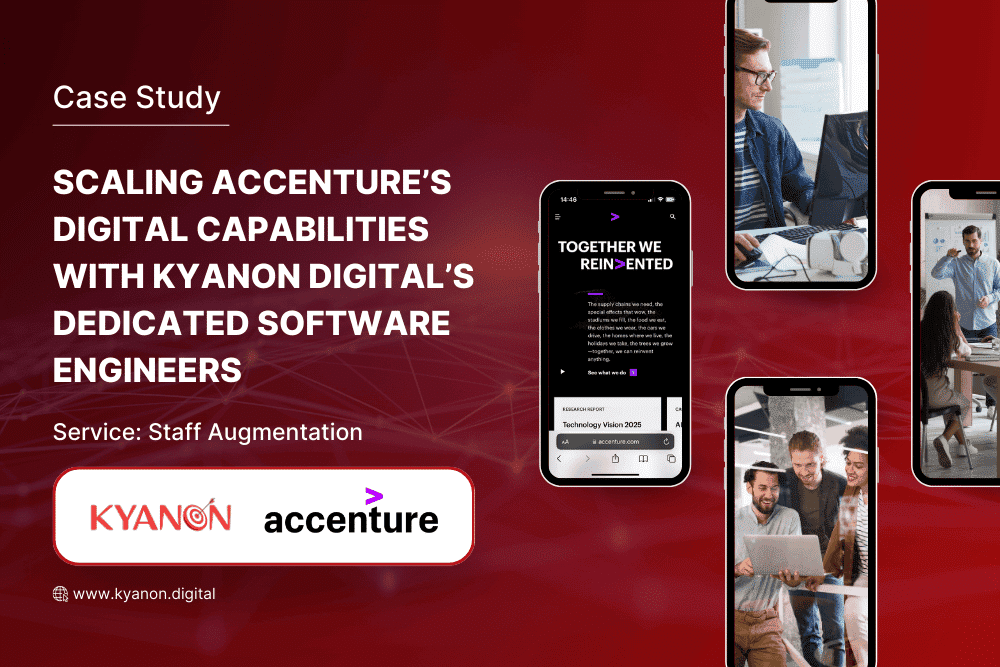
Accenture, a global leader in consulting and technology, partnered with Kyanon Digital to enhance its delivery capacity for digital transformation initiatives.
By embedding dedicated engineering teams directly into Accenture’s project squads, Kyanon Digital ensured seamless integration between business objectives and technical execution. This IT business partnership model enabled faster delivery cycles, consistent product quality, and the flexibility to scale up quickly based on evolving client needs.
The result was not only greater operational agility, but also the ability to deliver high-impact digital solutions more efficiently – demonstrating how a collaborative IT-business environment can maximize value creation across both internal teams and end clients.
To see how this collaborative IT-business partnership unlocked scalable growth and delivery excellence, read the full case study here.
From vendor to value co-creator: The role of external IT partnerships
In a modern digital ecosystem, a true IT business partnership extends beyond internal teams to include strategic external partners. The shift from vendor to value co-creator enables organizations to accelerate innovation and scale more efficiently.

Example: Unilever’s partnership with Microsoft demonstrates how an external IT business partnership can become a strategic driver of innovation. By leveraging Azure AI and cloud capabilities, Unilever has transformed its R&D process to be faster, more data-driven, and cost-efficient – cutting time-to-market while boosting sustainability.
Instead of merely procuring tools, businesses now co-develop tailored solutions with partners to:
- Solve complex challenges
- Streamline operations
- Unlock new revenue streams
This engagement model fosters shared accountability, continuous innovation, and business-aligned outcomes. According to the book IT Business Partnerships, organizations embracing this model see up to 13% higher ROI and enhanced agility compared to those with traditional vendor relationships.
By embedding IT business partner principles into external collaborations, companies gain a competitive edge and long-term digital resilience.
Measuring the success of an IT business partnership
To ensure your IT business partnership is delivering real business value, tracking performance through the right metrics is essential. These should go beyond system uptime or ticket resolution rates.
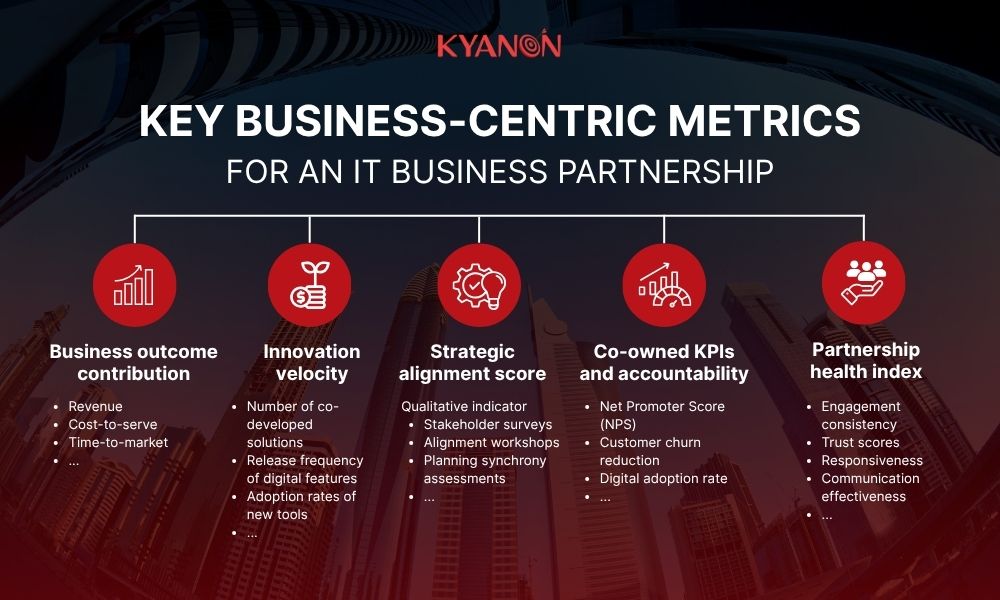
Business outcome contribution
- Measure how IT partnerships influence tangible results – such as increased revenue, reduced cost-to-serve, or shorter time-to-market.
- Example: Track revenue generated from digital channels powered by IT initiatives. This links tech performance directly to business growth.
Innovation velocity
An effective partnership should accelerate delivery. Useful metrics include:
- Number of co-developed solutions
- Frequency of digital feature releases
- MVP or prototype deployment speed. Faster rollout reflects high collaboration and a mature innovation process.
Strategic alignment score
- Gauge how closely IT and business are aligned in vision and priorities.
- Tools like stakeholder surveys or alignment workshops help reveal whether both sides are executing in sync – reducing friction and improving joint planning.
Co-owned KPIs and accountability
- Define shared success metrics – like NPS, customer churn rate, or digital adoption.
- When IT and business teams co-own results, decision-making becomes more collaborative and goal-oriented.
Partnership health index
- Beyond results, monitor the quality of the relationship itself.
- Track indicators such as engagement consistency, responsiveness, or trust levels. A healthy partnership culture enables agility and long-term performance.
By focusing on these metrics, organizations can ensure that their IT business partnerships consistently drive strategic value – not just operational support.
The future of IT business partnership
The future of the IT business partner role is embedded, collaborative, and AI-driven. As business needs evolve rapidly, static support models no longer suffice.
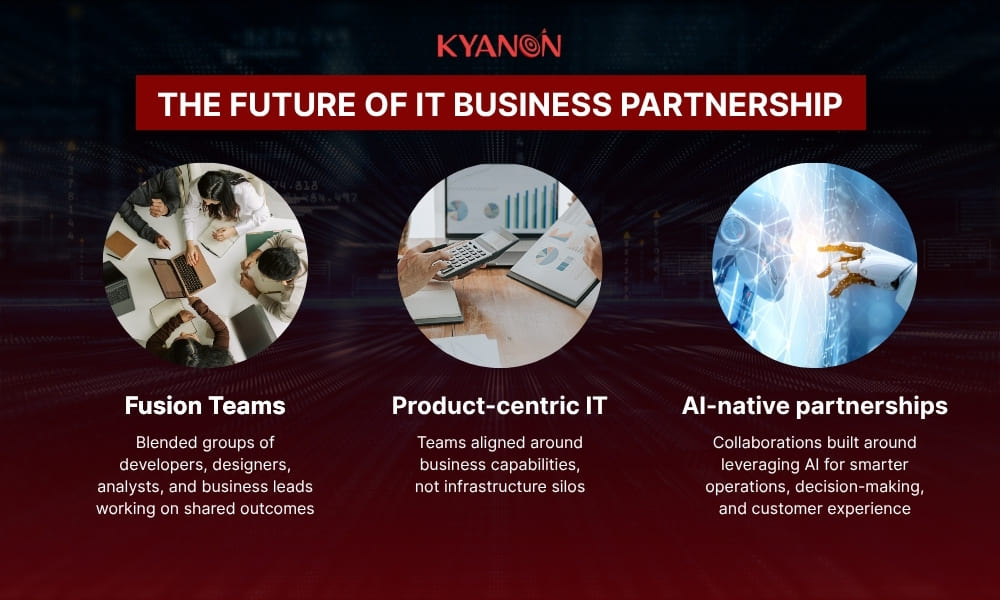
Emerging trends include:
Fusion teams
Cross-functional “fusion teams” are redefining IT collaboration. These teams unite developers, analysts, UX designers, and business stakeholders to deliver business outcomes – not just tech outputs.
- They blend real-time domain knowledge with technical expertise
- Drive faster speed-to-value and continuous innovation
- Enable IT to directly impact customer experience, not just maintain systems
Product-centric IT
Rather than structuring IT around systems, organizations are shifting to product-centric models.
- Teams are aligned with business capabilities (e.g., onboarding, order tracking)
- This supports continuous improvement and faster feedback loops
- IT becomes a growth enabler – focused on measurable business results and user experience
AI-native partnerships
AI is no longer an add-on – it’s becoming the foundation of modern IT-business collaboration.
- Next-gen partnerships embed AI into decision-making, operations, and customer engagement
- IT and business co-develop smart, scalable, self-optimizing strategies
- The goal: not just automation, but intelligent transformation at scale
The future of IT business partnership lies in co-ownership, adaptability, and intelligent design – where IT is no longer a service provider, but a strategic force driving business performance.
Final thoughts
A successful IT business partnership goes far beyond simply aligning IT with business goals – it’s about building a collaborative ecosystem that drives innovation, accelerates growth, and delivers measurable outcomes.
From redefining IT business partner roles and responsibilities to building agile engagement models, the shift toward integrated collaboration empowers companies to move faster, operate smarter, and continuously adapt to change. With fusion teams fostering co-creation, product-centric structures aligning IT to business capabilities, and AI-native partnerships unlocking new frontiers of decision-making, the future of IT-business collaboration is deeply embedded and innovation-driven.
Kyanon Digital as your trusted IT business partnership

About Kyanon Digital
Kyanon Digital is a Vietnam based leading Digital & Technology Company empowering businesses to achieve Growth and Impact through Completed Technology Solutions. We are a trusted partner to Make Digital Impact. It’s not only about Technology, it’s about the impact of business processes, ensuring happy customer experience and optimizing operations.
Founded in 2012, Kyanon Digital is a dynamic and forward-thinking agile digital transformation partner. With over 13 years of experience, more than 500 experts across Vietnam and Singapore, and offices in Vietnam, Singapore, Thailand, Australia and Malaysia.
Recognized 4 years in a row (2020–2024) by VINASA for excellence in digital transformation, e-commerce & logistics solutions, Kyanon Digital is also recognized regionally for innovation and impactful digital solutions at Asian Technology Excellence Award 2023.
Our five core services
- Strategise & Plan: We help define technology goals, develop architectural strategies, and create roadmaps to guide digital transformation journeys.
- Build & Engage: Delivering high-quality, scalable solutions through custom software, web and mobile app development, AI, and Big Data, driven by agile methodologies and a human-centric design approach.
- Integrate & Automate: Enhancing efficiency through composable architecture, middleware integration, and secure, high-performance systems that automate and streamline workflows.
- Analyse & Augment: Empowering organizations with data-driven insights through advanced analytics, data warehousing, governance, and cutting-edge AI/GenAI solutions.
- Operate & Support: Providing ongoing support and optimization services, including data entry, content moderation, managed services, and tailored e-commerce support.
Ready to drive real digital impact?
Let Kyanon Digital become your strategic IT business partner, transforming tech into value, together. Contact us today!
References
- The keys to a successful digital transformation, McKinsey
- Case Study: Spotify – Transforming Product Development Through Agile and Scrum, Tamal Majumder (Udemy Coach)
- Eight Important Elements Of Successful Business Partnerships, Forbes
- Principles for Business Partners: A Strategic Guide, Oneflow
- What Makes a Good Business Partnership?, LinkedIn
- Case Study: Spotify – Transforming Product Development Through Agile and Scrum, LinkedIn
- Exploring Key Elements of Spotify’s Agile Scaling Model, Medium
- Business Success: A Modern Engagement Model for IT and Business, CIO Journal
- Being an IT business partner, Robert Walters China
- IT Business Partner – Requirements, Career, and Earnings, HRK
- Mid-size retailer implements AI-based demand forecasting to manage inventory stocks, Aglowid IT Solutions
- Business Trends 2025, IBM Institute for Business Value
- Technology Industry Outlook, Deloitte
- West Monroe Study Finds Correlation Between Digital Maturity and Increased Revenue Growth, Profitability, West Monroe
- How Real-Time Data Analytics Is Changing the Decision-Making Process in 2025, Medium
- How Business Automation Transforms Efficiency & Growth, LinkedIn
- ING’s Agile Transformation, McKinsey
- Partnering To Shape The Future: IT’s New Imperative, McKinsey Digital
- Best Practices for Creating and Maintaining a Partner Ecosystem, LinkedIn
- Bridging the Divide: Transforming IT & Business for Maximum Value, LinkedIn
- The Future of R&D: How Unilever is Transforming Innovation with Microsoft, Unilever
- Digital Transformation 2024 Survey, Deloitte
- Maximizing Business Value Through Partnership, LinkedIn
- Best Practices To Maximize the Value You Get From Partners, Forrester
- Enterprise Partnerships: KPIs and Metrics, PartnerStack
- Know Your Key Partnership Performance Indicators, Guidance
- Measuring Success in Your Partner Ecosystem, Partnership Leaders
- Fusion Teams: The Future of Business and IT Collaboration, Gartner
- Fusion Teams Explained: Benefits, Roles, Examples, Mendix
- Why the Product-Centric Approach is a Need, Not a Trend, LinkedIn
- The Rise of AI-Native Workers is Redefining Professional Identity, LinkedIn
- CIO Insights That Drive Business Impact, Gartner


